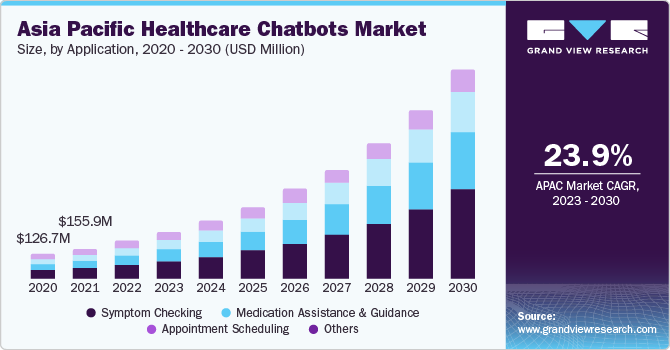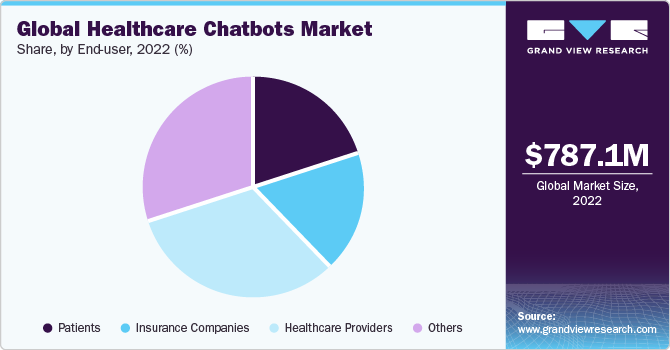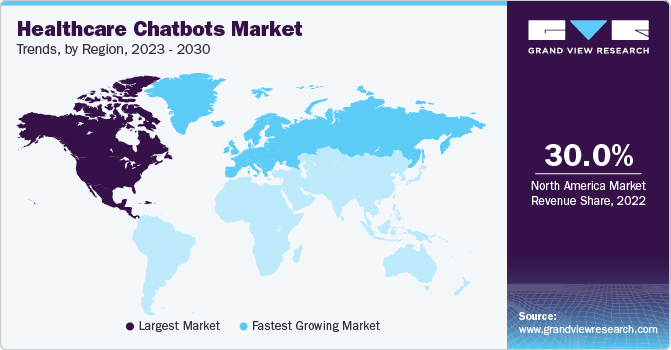- Home
- »
- Next Generation Technologies
- »
-
Healthcare Chatbots Market Size And Share Report, 2030GVR Report cover
![Healthcare Chatbots Market Size, Share & Trends Report]()
Healthcare Chatbots Market Size, Share & Trends Analysis Report By Component (Software, Services), By Application (Appointment Scheduling, Symptom Checking), By Deployment, By End-user, And Segment Forecasts, 2023 - 2030
- Report ID: GVR-4-68040-152-4
- Number of Report Pages: 100
- Format: PDF, Horizon Databook
- Historical Range: 2017 - 2021
- Forecast Period: 2023 - 2030
- Industry: Technology
Healthcare Chatbots Market Size & Trends
The global healthcare chatbots market size was estimated at USD 787.1 million in 2022 and is expected to expand at a compound annual growth rate (CAGR) of 23.9% from 2023 to 2030. Healthcare payers operate chatbots to make connections with prospective clients. Chatbots for healthcare are systems that answer people's questions. The deployment of state-of-the-art technology enables this program to assist doctors in addressing minor patient concerns. Clinical teams claim to have saved a substantial amount of time due to this technology, thus freeing up staff members to concentrate better on their core tasks. The healthcare industry is experiencing a significant surge in demand for these digital assistants because of modern technology automating several operations.

The market is a rapidly expanding sector within the healthcare industry that involves the use of artificial intelligence (AI)-powered chatbot applications to improve patient engagement, streamline administrative tasks, provide health information, and support telemedicine services. These chatbots, often integrated with electronic health records (EHRs) and telehealth platforms, offer 24/7 accessibility, personalized interactions, and efficient appointment scheduling, reducing the burden on healthcare professionals and enhancing the patient experience.
Healthcare chatbots were developed primarily to relieve the workload of primary care physicians and to assist people in learning how to take better care of their own health. For instance, a lot of individuals schedule a colonoscopy and then either cancel it or don't show up. Studies reveal that approximately 40% of patients in vulnerable or underprivileged populations do not complete the treatment, highlighting how serious the issue is in these groups.Northwell Health is a nonprofit integrated healthcare network with more than 81,000 employees that serves as both the largest private employer and healthcare provider in New York State.
Component Insights
The software segment led the market in 2022 accounting for a revenue share of over 62.0%. The software segment is growing due to enhanced technological features in chatbot software, like mobile platform compatibility, cloud-based deployment, interference engine, multilingual capabilities, Natural Language Processing (NLP), Application Programming Interface (API), and single point of search.Furthermore, compared to rule-based chatbots, artificial intelligence software-powered chatbots are the most sophisticated since machine-learning chatbots are typically more conversational, data-driven, and predictive. No matter how the inquiries are expressed, the Al software-based chatbots cannot only comprehend the patient's intent but also provide precise responses. For example, they can schedule consultations and use a symptom checker to diagnose the illness.
The service segment will register a CAGR of 24.5% from 2023 to 2030. Healthcare chatbot services are digital technologies that use conversational interfaces to offer information, assistance, and services to patients, healthcare practitioners, and other industry stakeholders. AI plays a significant role in healthcare chatbot services. AI chatbots schedule appointments and handle requests for prescription renewals in addition to offering patients basic informational support (such as details about visiting hours and addresses). Moreover, healthcare chatbot services allow chatbots to evaluate a patient's symptoms to determine whether they need medical attention. In addition, it can enable medical staff to track patients' conditions and link a patient with a doctor for a consultation.
Deployment Insights
The cloud segment is expected to register the highest revenue growth of over 63.4% in the forecast period. Cloud-based chatbots can be adjusted less, require less initial investment, and are more accessible than on-premises chatbots. Healthcare companies simply scale their chatbot services up or down in response to demand due to cloud-based models in healthcare chatbots. This is essential for effectively managing different user interaction levels, particularly during peak hours.To assist healthcare firms in complying with regulatory standards, such as the Health Insurance Portability and Accountability Act (HIPAA) in the United States, reputable cloud providers make significant investments in security measures and issue compliance certifications. They offer services and products for data encryption, access control, and compliance.
The on-premises segment accounted for 23% CAGR over a forecast period. Healthcare organizations that use on-premises chatbots host the chatbot's data, services, and infrastructure on their own servers or data centers. When a chatbot is deployed on-premises, all of its parts are physically housed and managed by the healthcare institution, as opposed to cloud-based models where resources are maintained in a remote cloud environment. Direct control over data is a major factor in healthcare businesses' decision to use an on-premises strategy. This is particularly crucial for private and sensitive patient health data since it gives the company complete control over data security and privacy.
Application Insights
The symptom-checking segment dominated the market with a revenue share of over 37% in 2022. Chatbots for healthcare and symptom checking make healthcare solutions easily available to a large number of people. These chatbots allow patients to obtain quick information about their health concerns from anywhere at any time, which may cut down on needless ER visits and doctor appointments. Medical chatbots are excellent at classifying patients according to the intensity of their symptoms. These chatbots work by posing a series of questions, evaluating the user's answers, and classifying the user into risk categories, which allows the chatbots to prioritize persons with more severe symptoms for prompt medical attention. This simplifies the healthcare system and aids in more effective resource allocation for providers.
The appointment scheduling segment will grow significantly registering a CAGR of 24.8% from 2023 to 2030. Appointment booking using AI systems is one of the features of automated patient support that enables patients to book appointments with ease and without the hassle of a challenging user interface. Appointments with selected providers can be easily scheduled, canceled, or rescheduled by patients. Healthcare automated patient chatbots are particularly helpful as they respond to queries from worried patients or their caregivers that are unquestionably important to answer but do not require highly qualified medical personnel to respond to. These technologies save time wastage for patients and healthcare practitioners by avoiding the need for patients to schedule an appointment only to get their queries answered. They also deliver helpful information promptly augmenting the market growth.
End-user Insights
The healthcare providers segment accounted for the highest share of over 34.4% in 2022. Clinicians, physicians, and healthcare organizations are examples of healthcare providers. To make important judgments, healthcare providers must be able to diagnose disorders and evaluate a vast amount of healthcare data. Healthcare practitioners are increasingly using IT-enabled techniques and software for better treatment possibilities and accurate disease identification to save costs and improve the quality of service. For example, doctors frequently utilize the chatbot SafeDrugBot to identify safe medications that can be given to expectant moms and nursing mothers.

The patients segment is anticipated to witness a CAGR of 25.2% over the forecast period. The majority of end-users are patients. To better understand their diseases, patients use apps like symptom checks and medical triage tools. People connect with virtual healthcare assistants to get the right medical information depending on their symptoms, or they can use healthcare chatbots on social media, mobile, and medical websites. When prospective patients visit a website, healthcare chatbots engage with them, offer a potential diagnosis, assist in locating specialists, set up appointments, and facilitate better access to the appropriate therapies. Chatbots that serve as medical assistants, like Florence and Melody, are becoming more and more popular since they remind patients to take their medications on schedule and provide information if a dosage is missed.
Regional Insights
North America accounted for the highest share of over 30% in 2022 due to the presence of key companies, high levels of investment in research & development, and the growing demand for virtual healthcare services. Furthermore, the regional market is growing because of the increased prevalence of chronic illnesses and the rising need for patient engagement programs. Due to the extensive use of technology and increased R&D spending, North America is witnessing tremendous market expansion. This market is anticipated to grow due to the high concentration of key companies in the area, strategic alliances, quicker FDA approvals, and significant R&D spending.

Europe is anticipated to witness a CAGR of 25.4% from 2023 to 2030 due to the growing demand for virtual healthcare services and desire to lower healthcare expenses in the area, Europe is a sizable market for healthcare chatbots. Due to the presence of important market participants and rising use of digital healthcare solutions in these nations, the UK, Germany, and France are the main contributors to the Europe regional market growth.
Key Companies & Market Share Insights
Prominent firms have used product launches and developments, followed by expansions, mergers and acquisitions, contracts, agreements, partnerships, and collaborations, as their primary business strategy to increase their market share. Companies have used various techniques to enhance market penetration and boost their position in the competitive industry. For instance, in April 2023Sensely Labs revealed that ChatGPT has been initially integrated into its front door navigator product. With the help of Front Door Navigator, insurance policyholders may easily and quickly receive intuitive answers to their most important queries.
Key Healthcare Chatbots Companies:
- Your.MD Ltd.
- HealthTap Inc.
- Sensely Inc.
- Buoy Health Inc.
- Infermedica
- Babylon Healthcare Service Limited
- Baidu Inc.
- Ada Digital Health Ltd.
- PACT Care BV
- Woebot Labs Inc.
- GYANT.Com Inc.
Healthcare Chatbots Market Report Scope
Report Attribute
Details
Market size value in 2023
USD 972.5 million
Revenue forecast in 2030
USD 4,355.6 million
Growth rate
CAGR of 23.9% from 2023 to 2030
Base year for estimation
2022
Historical data
2017 - 2021
Forecast period
2023 - 2030
Quantitative units
Revenue in USD million and CAGR from 2023 to 2030
Report coverage
Revenue forecast, company ranking, competitive landscape, growth factors, and trends
Segments covered
Component, deployment, application, end-user, and region
Regional scope
North America; Europe; Asia Pacific; Latin America; MEA
Country scope
U.S.; Canada; UK; Germany; France; China; Japan; India; South Korea; Australia; Brazil; Mexico; KSA; UAE; South Africa
Key companies profiled
Your.MD; HealthTap Inc.; Sensely Inc.; Buoy Health Inc.; Infermedica; Babylon; Healthcare Service Ltd.; Baidu Inc.; Ada Digital Health Ltd.; PACT Care BV; Woebot Labs Inc.; GYANT.Com Inc.
Customization scope
Free report customization (equivalent up to 8 analysts working days) with purchase. Addition or alteration to country, regional & segment scope.
Pricing and purchase options
Avail customized purchase options to meet your exact research needs. Explore purchase options
Global Healthcare Chatbots Market Report Segmentation
This report forecasts revenue growth at global, regional, and country levels and provides an analysis of the latest trends in each of the sub-segments from 2017 to 2030. For this study, Grand View Research has segmented the healthcare chatbots market report based on component, deployment, application, end-user, and region:
-
Component Outlook (Revenue, USD Million, 2017 - 2030)
-
Software
-
Services
-
-
Deployment Outlook (Revenue, USD Million, 2017 - 2030)
-
Cloud
-
On-premises
-
-
Application Outlook (Revenue, USD Million, 2017 - 2030)
-
Symptom Checking
-
Medication Assistance & Guidance
-
Appointment Scheduling
-
Others
-
-
End-user Outlook (Revenue, USD Million, 2017 - 2030)
-
Patients
-
Insurance companies
-
Healthcare providers
-
Others
-
-
Regional Outlook (Revenue, USD Million, 2017 - 2030)
-
North America
-
U.S.
-
Canada
-
-
Europe
-
UK
-
Germany
-
France
-
-
Asia Pacific
-
China
-
Japan
-
India
-
South Korea
-
Australia
-
-
Latin America
-
Brazil
-
Mexico
-
-
Middle East and Africa (MEA)
-
Kingdom of Saudi Arabia (KSA)
-
UAE (United Arab Emirates)
-
South Africa
-
-
Frequently Asked Questions About This Report
b. The global healthcare chatbots market size was estimated at USD 787.1 million in 2022 and is expected to reach USD 972.5 million in 2023.
b. The global healthcare chatbots market is expected to grow at a compound annual growth rate of 23.9% from 2023 to 2030 to reach USD 4,355.6 million by 2030.
b. North America dominated the healthcare chatbots market with a share of 30.7% in 2022. This is attributable to the presence of numerous significant competitors, high levels of investment in research & development, and the growing demand for virtual healthcare services.
b. Some key players operating in the healthcare chatbots market include Your.MD, HealthTap Inc., Sensely Inc., Buoy Health Inc., Infermedica, Babylon, Healthcare Service Limited, Baidu Inc., Ada Digital Health Ltd., PACT Care BV, Woebot Labs Inc., GYANT.Com Inc.
b. Key factors that are driving the market growth include the need for improved patient engagement, the growing demand for accessible and cost-effective healthcare services, and advancements in natural language processing (NLP) and AI technologies.
Share this report with your colleague or friend.
![gvr icn]()
NEED A CUSTOM REPORT?
We can customize every report - free of charge - including purchasing stand-alone sections or country-level reports, as well as offer affordable discounts for start-ups & universities. Contact us now
![Certified Icon]()
We are GDPR and CCPA compliant! Your transaction & personal information is safe and secure. For more details, please read our privacy policy.
We are committed towards customer satisfaction, and quality service.
"The quality of research they have done for us has been excellent."





